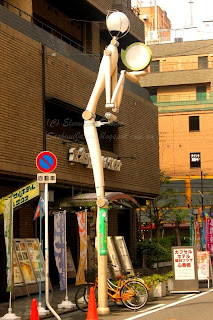Formerly known as Naniwa and Japan's first ever capital city, Osaka (literally, "large hill/slope") had served as Japan's economic centre for many centuries, and retained vital trade connections with neighbouring cities (Nara, Kyoto) and countries (China, Korea). The city was also (one of) the most important industrial centres for the modernisation of Japan following the opening of its borders to foreign trade. Many districts of Osaka were destroyed by Allied air raids during World War II, but the city was quickly rebuilt after the war and continued to this day to be one of Japan's major industrial centres.
One might catch sight of Mount Fuji enroute on the Shinkansen to/from Osaka pending local weather conditions. On my first trip to Osaka in the Shinkansen, Mt Fuji was hidden behind lots of clouds (though you may just be able to make out its outline in the photo).
Osaka Castle
The original Osaka Castle (or 'Osaka-jo') was built by Toyotomi Hideyoshi, the last warlord of Japan's feudal past who successfully united the whole country. In the 1600s, the castle was destroyed by insurgents and later by lightning. The present castle was reconstructed over 300 years later and managed to survive the WW2 air raids. Its interior now houses a museum of Japanese feudal history.
What I didn't realise when I visited Osaka Castle was that I entered through its rear gate.
The said rear gate.
Through the gate, I was greeted by an imposing view of the castle fortress' moat.
The bridge leading across the castle moat.
After a tiring climb up a steep hill, I finally arrived at the castle. That glass column to its left is the disabled access lift.
The ticketing gate and steps up to the castle.
Lots of exhibits about major wars during Japan's feudal history, especially the times concerning Toyotomi Hideyoshi.
There's an area in the museum where visitors can dress up and have their photos taken as a feudal warlord and/or lady.
Lots of people in line so I decided to take a rain check.
Osaka Castle utilizes both the dry and wet moats as seen in the photo above.
One of the rail sculptures on the pathway leading to/from the entrance.
Osaka City Centre - Various Sights
The city of Osaka itself is naturally very industrialised, though I also found certain parts of it to be fairly run down and even filthy. The public transport system is very extensive but not nearly as complex as Tokyo's. That said, Osaka does have two major city centres centred around the Umeda and Namba train stations, a circular city rail loop, and is served by more than seven railway/subway companies. The pace of Japan's fifth largest city is slower that Tokyo's. I also found the people of Osaka to be generally more laid back and slightly friendlier as compared to Tokyoites.
One of the things I love about the Kansai region of Japan is its collection of localised accents, collectively known as the 'Kansai-ben'. Osaka has its own accent known as the 'Osaka-ben', which I simply adore. On my first visit to Osaka, I got lost on one its rail lines, reached the terminal station, and was patiently guided back to the main city loop by a friendly train cleaner speaking with a heavy Osaka-ben. I was most grateful to the staff but also pleasantly intrigued by the accent at the same time. Every time I visited one of Osaka's many covered arcades, I was always 'tickled' by the local accent and unique language phrases.
These are apparently mascots of local comedians.
One of the covered arcades in Namba area.
Here I found Chibo Okonomiyaki - a classy local restaurant specialising in the local favourite. I was seated along the counter watching the chef cook the okonomiyaki (known in Western countries as, "Japanese pancake" - it consists mainly of cabbage).
The finished product with bonito (dried fish flakes) topping - I'd never had a softer or more delicious okonomiyaki. It was cooked to perfection and consumed with extreme speed. Lol.
A famous local sight known as the 'Glico running man'. Glico is a local candy manufacturing company, and its neon sign's most recent incarnation featured the Osaka castle and Olympic tracks as background.
Another local favourite - the Takoyaki (balls of fried flour containing a piece of octopus each).
One of the rivers running through the city.
One of the streets in 'America-mura' (or 'America Village').
A large chain bookstore selling lots of second-hand manga and doujinshi.
One of the curiously-shaped street lamps in America-mura.
An octopus-shaped sign in America-mura.
Next is Dotonburi - a short and quaint street featuring lots of little shops.
Not sure if this was a tea-house or cafe but I loved the architecture.
One of the several bridges within Namba district.
Entrance to an underground carpark!
Lots of plastic food samples on display.
Another shot of food sample displays.
A theatre for Kabuki - a classic Japanese dance and drama artform.
A famous store specialising in 'kani' (crabs). The legs on that huge crab will move periodically.
Lots of pedestrians on a shopping street.
Ebisubashi - (one of) the longest series of covered arcades in Namba.
The interior of one of the arcades making up Ebisubashi.
Interesting architecture but no idea what that building is.
Another covered arcade.
Next I headed to Den Den Town - Osaka's equivalent and answer to Tokyo's Akihabara. People are technically not allowed to take photos of staff dressed up as 'maids' but I managed to get this shot when she had her head turned.
Osaka's Den Den Town.
Lots of capsule machines lining the streets.
That's a maid cafe. When I tried to take a photo of the food display in front of the shop, one of the staff/maids came out and firmly told me not to do so.
A game centre.









































No comments:
Post a Comment